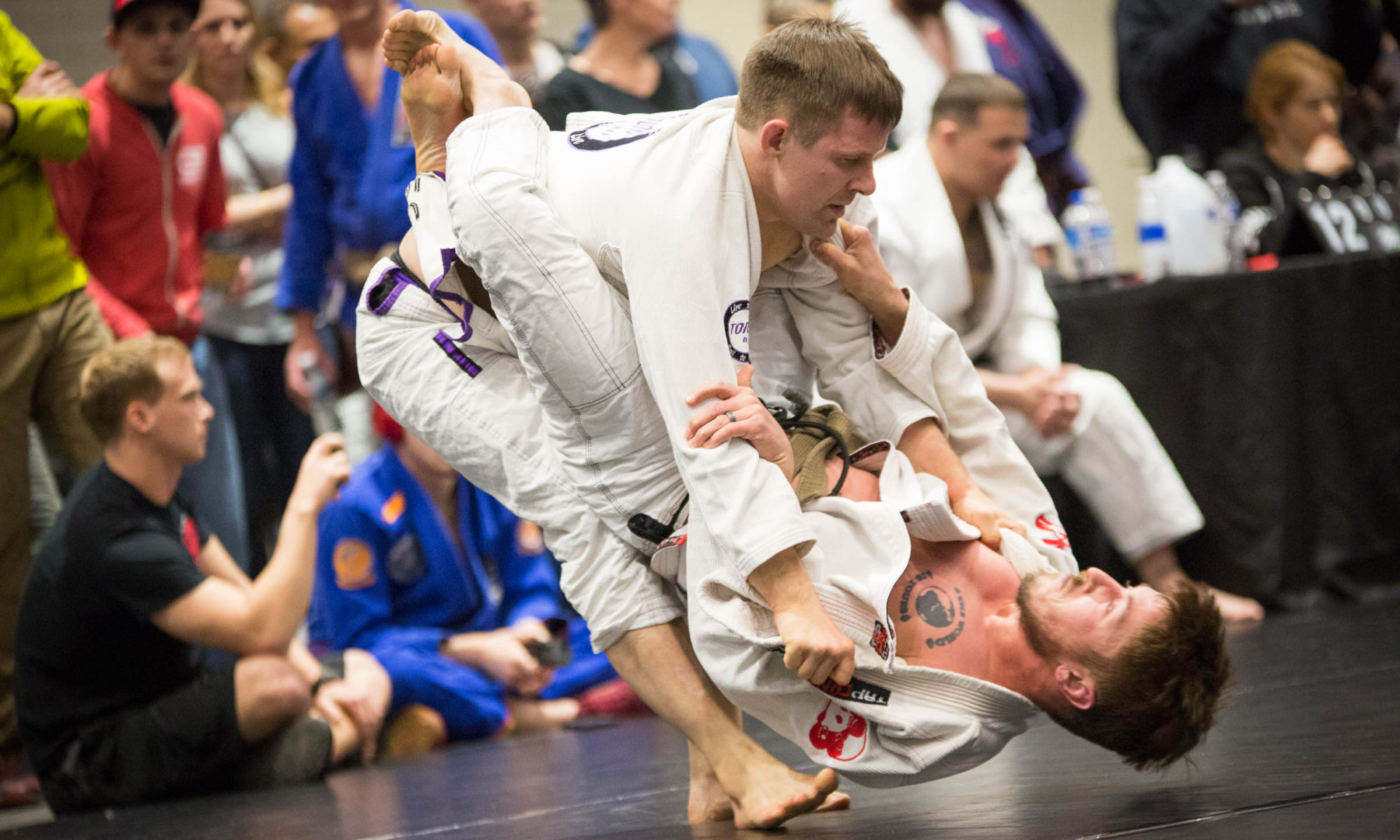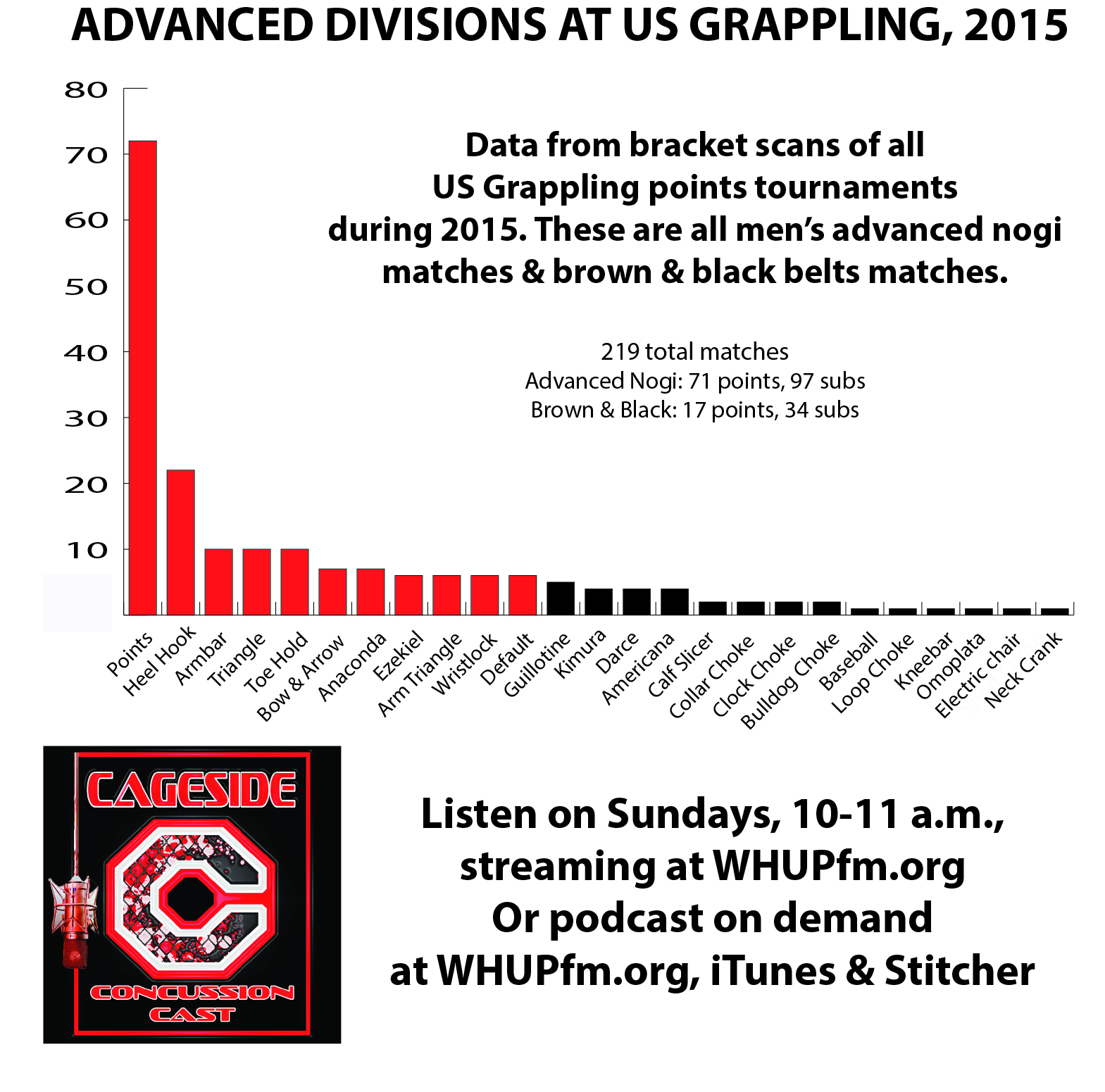What Were The Top Submissions of 2015?
There are two reasons I wanted to analyze all the matches from US Grappling‘s points tournaments last year. The first: examining big-picture trends can tell us a lot about what works in practice, what people are doing, what we need to be drilling and what we need to be alert about defending.
The second reason is that I am a giant nerd, and I love data, and I wanted to talk about data on the year-end Cageside ConcussionCast. I go way more in-depth over there, and you can listen to the archived show here or subscribe on iTunes. What follows is a breakdown of all the matches for which we have information in 2015.
To get this, I went through all of the scanned brackets that were available (thanks, Brian & Chrissy Linzy) and put the results into a Google Spreadsheet for ease of data manipulation. There are some caveats about this data, but only super-nerds care about that, so I’ll save them until the end. What you really care about are the results, so let’s get into them.
SUBMISSIONS ARE SLIGHTLY MORE LIKELY THAN POINTS
Generally speaking, about half of US Grappling matches go to points. Of the 2091 matches I analyzed, about 1100 ended in submission, so slightly more than 50 percent end with taps. If you’re betting on whether a match will have a submission or not, you’re slightly better off betting “yes,” but keep in mind that you’re better off betting on points than on any specific submission. Even the armbar. But if you’re going to bet on one submission …
ARM BARS RULE, & SO DO HEEL HOOKS
The arm bar is the most common submission in every division group except one, which is 30+ men’s nogi, where it runs a close second to the Rear Naked Choke (RNC). The armbar is still king in the Men’s Purple to Black belt gi divisions, but it’s close: the arm bar beats the bow & arrow choke by a narrow margin.
(To avoid confusion on something I say below, when I say “division group,” I mean “Men’s NoGi, Women’s Gi,” and those larger groups. The arm bar isn’t the top submission for Men’s Advanced NoGi, for example, but it is the top submission for Men’s NoGi generally. I broke the data down this way for sample size purposes.)
Here’s the chart of all the most common submissions, in order, with the top 15 in red:
Of course, the arm bar is allowed in every division, so that gives it an advantage in terms of pure numbers. We’d expect the main submission to be something that every division, gi or nogi, white belt to black belt, can do. We wouldn’t necessarily expect the arm bar to be this far ahead of everything else, though, so that feels significant.
A related point: chokes using the kimono can only be done in half of the divisions, so they’re way more powerful than they look from this chart. The good old-fashioned collar choke performs very well, as does the bow & arrow, especially in the upper belt divisions. The same applies to leg locks. Aside from the straight ankle lock, only upper belts get to use them.
And if you break the data down into specific sub-divisions, you see how powerful the heel hook is. It’s only allowed in adult advanced NoGi, and yet there were 22 heel hook submissions — more than twice the next-most common submission. By the way, there were also 10 toe holds and a couple of calf slicers, so hide your feet in adult advanced.
FUNDAMENTALS WINS TOURNAMENT MATCHES
Here are the top five submissions. Let me know if you see a common thread.
Armbar: 279
Rear Naked Choke: 105
Triangle: 102
Collar Choke: 88
Guillotine & Kimura (tie): 68
That’s right: the most common submissions are all moves you’re going to learn in the first six months. That stuff doesn’t stop working. Keep drilling it.
Yes, fancy stuff happens. We had an electric chair submission (what’s up, Marcel Fucci?). A gogoplata (what’s up Alec Cerruto?). And two Peruvian neckties, in the beginner division and white belt division (stop watching YouTube, guys). But for the most part, it’s the basics that get it done.
To give you an idea about this: the 6th most popular submission is the bow & arrow choke. There were more bow & arrows than the bottom 17 submissions combined, including all the funky stuff.
MORE POPULAR THAN I THOUGHT
Wrist locks. The dandy is back with a vengeance, getting 13 submissions. That’s twice as much as the baseball choke. Cutter chokes are also more popular than I would have guessed: there were more cutter submissions than the North South choke and the Anaconda choke combined.
LESS POPULAR THAN I THOUGHT
Three omoplata submissions all year. Yes, most people use the omoplata as a sweep. And maybe this is because it’s one of my favorite moves, but there were as many bulldog chokes (3) as there were omoplatas, which surprised me.
UNDER PRESSURE
There were four taps to pressure last year. The surprising part about this: three came from blue belts, one from a purple belt. There were more taps to pressure last year than taps to clock chokes (3, two by Jake Whitfield) or loop chokes.
30+ MEN GET HURT AND WOMEN ARE TOUGHER THAN MEN.
I rolled injury, default and disqualification into one category (and there was only one DQ that I remember counting) so this number tabulates matches ending in injury and people not showing for the next match, either due to injury, fatigue, or whatever.
The realities of our bodies: they get more fragile as they age. Another reality: one gender pushes out babies. Thus, it should be no great surprise that older guys (like me) get hurt at a higher rate and women just don’t default from matches at anywhere near the rate guys do.
Let’s start with the old guys: of the 47 total men’s division defaults, 17 were 30+ men. There were 441 30+ men’s matches. One in 26 of those matches had an injury default. This is still not a huge rate, given that we try to bend each other’s joints the wrong way, but it’s far and away the highest rate of the groups I looked. By contrast, the total injury rate for men is one in 38.5 matches.
What about the women? 282 matches, four defaults. FOUR. That’s about one in 70 matches. And it gets more impressive: I was reffing the tournament where two of those defaults took place, and at least two of them were closeouts. That’s when two teammates meet in the finals and choose not to compete against each other, meaning those were non-injury defaults as well. In reality, that number is more like 1 in every 140 matches.
Granted, this is a small sample size. But still, it’s worth noting. Women of jiu-jitsu, Kathleen Hanna and I tip our caps to you.
ADVANCED DIVISIONS SHOW MUCH THE SAME TRENDS, BUT WITH LEG LOCKS
So, when you break the data down further to just a few advanced divisions, the picture changes slightly. I grouped the information from adult advanced NoGi and brown & black belt gi divisions.
The results: armbars are still powerful, but leg locks really change the game. Heel hooks are very common, and toe holds aren’t far behind. (Also, big surprise: in 219 matches, zero rear naked chokes or straight ankle locks.) Consider this, too: advanced grappling matches are slightly more likely to end in submission than other matches, from this sample. Out of 219 total matches, 131 ended in submission. Interestingly, in a fairly small gi sample of 51 matches, there were twice as many taps as there were matches that went to points (34 to 17).
To close this out, let me show you the broad division groups I put the numbers into. I combined them this way for sample size purposes.
Here are the top five submissions for each broad division group:
| Men White & Blue Belt Gi | Men Purple to Black Belt Gi | Men NoGi | Women Gi | Women NoGi | 30+ Men Gi | 30+ Men NoGi |
| Armbar | Armbar | Armbar | Armbar | Armbar | Armbar | RNC |
| Collar Choke | Triangle | RNC | Collar Choke | Americana | Collar Choke | Armbar |
| Triangle | Bow & Arrow | Guillotine | Americana | RNC | Bow & Arrow | Kimura |
| Kimura | Ezekiel | Heel Hook | Bow & Arrow | Guillotine | Triangle | Guillotine |
| Bow & Arrow | Collar | Arm Triangle | Ezekiel | Kimura | Kimura | Arm Triangle |
By the way, if I put “Default” on here, it’d be the No. 3 submission for men’s 30+ in the gi.
FINALLY, A NOTE ON THE DATA
Any project has limitations, and I want to acknowledge them. For one thing, this only tabulates the points tournaments, not the US Grappling Submission Only tournaments. If there is enough interest, I’ll do a post about those as well. Also, some data is missing: the majority of table workers did a great job with writing down results, but there were many brackets with either no information about how someone won, or the information was vague (“verbal submission,” but not what submission). So I didn’t include the information if it wasn’t reliable.
There are also issues with terminology. Some of this is easy. I rolled “keylock” and “Americana” into one category, which is obvious, and “Darce” and “Brabo” into one category. But there is also the more vague “shoulder lock,” which ended up getting counted as a kimura. And the whole “collar choke” category includes all collar chokes, because the brackets don’t specify from mount or from guard. That’s information I’d like to have, but we just don’t have it. Then, you have the possibility of transcription errors, so we should take this for what it’s worth: a fun look at big-picture data.
I guess I’m saying this: Before you use it for your master’s thesis, maybe hit me up with an e-mail. Thanks for reading!
The Top 10 Things To Think About Before Your First Tournament
Some of my training partners are competing for the first time at Toro BJJ Presents US Grappling Greensboro this weekend. This is great, and I’m proud of all of the people who are stepping on the mat to compete. Jiu-jitsu competition has real benefits for your training, as this article by Jake Whitfield shows.
Partially for my friends, and partially for other folks who will dip their toes into tournament waters in the future, I thought I’d put together some advice. When you’re getting ready for your first tournament, here are 10 things I think you should consider.
10. Registration
Seems like it goes without saying, but put some thought into what division you want to enter. Many tournament offer both gi and no-gi divisions, some offer age groups, and most offer “absolute” divisions where you can compete against anyone of any weight class. In general, I advise entering as many divisions as you can: you’re in this to learn jiu-jitsu, and the more matches you get, the more you’ll learn. Besides, you can always drop out if you’re exhausted after one or two divisions, but you can’t enter new divisions the day of the event.
9. Preparation
Not just physical preparation through training, either. That part goes without saying, and your instructor and teammates know what you’ll need to do in training to get ready. For your part, make sure you show up ready to compete. Get a good night’s sleep beforehand. Pack a bag full of healthy food, water and other fluids, and whatever gear you’ll need. You never know what the food options will be at the event, and it’s best to have healthy fruit between matches rather than a greasy piece of pizza.

8. Goals
Maybe you want to win every match (and good luck with that!). Maybe you have a lot of experience competing in other things and you know you enjoy the challenge. Or maybe this is your first real athletic experience, and you just want to see what it’s like. Your goals for the tournament depend on your own background and training. So be clear with yourself about what you expect from the experience.
7. Survival
If this is your first tournament, you’re probably a white belt, and if you’re a white belt, your focus should be to survive first. From there you can advance to the other aspects of the game. Jiu-jitsu is a defensive art, and surviving is a victory! If we look at success as a pyramid, with survival at the base and submitting your opponent on top, you have to start at the beginning. You can’t achieve success without surviving, so be sure your defensive game is tight.

Most of the things I’ve listed so far are things I think that new competitors should think about and consider. The next few are specific techniques that work for me, and that I hope help you as well.
6. Best-Case Strategy
Have a plan for your match. While it’s unlikely that your match goes exactly the way you envision it, the very act of visualization helps. Multiple studies have shown that visualization improves athletic performance, and the practice of thinking through how you want your matches to go only helps remind you of the techniques you want to use.
For example, my first tournament I planned to do this: take my opponent down with a single leg; open and pass his guard with a stack pass; control him in side control; pass to mount using a knee drive; try to collar choke him from mount, and either finish, or force him to give me his back; and finally finish with a rear naked choke.
Exactly zero of my matches went this way, but I firmly believe that the tournament went better because I had a plan in place. What’s your plan in the ideal world? Even if we don’t live in the ideal world, you should be able to answer this question.
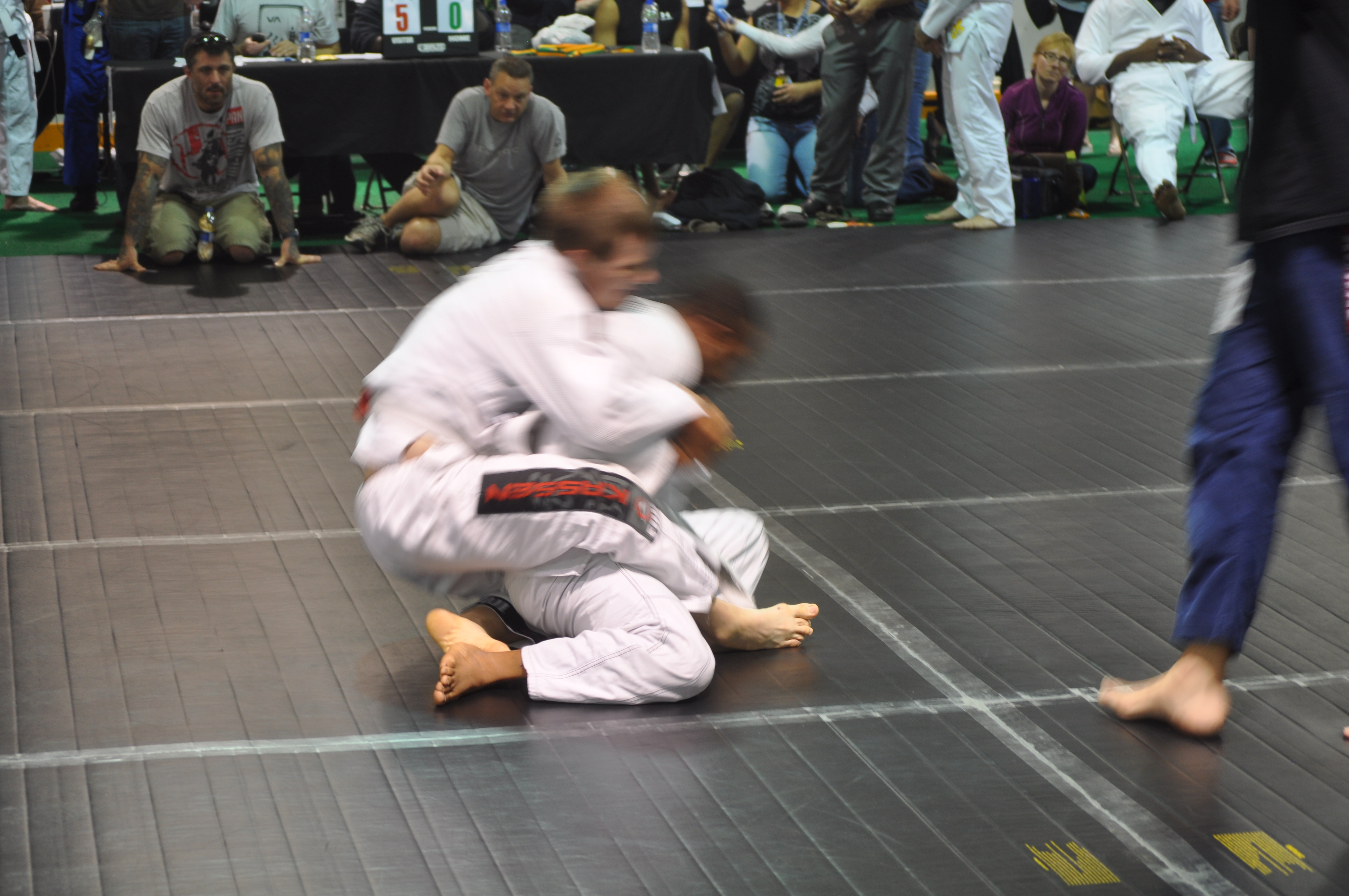
5. Techniques For Each Major Position
Things go wrong. In the middle of life we lose a toe or we discover our girlfriend loves Nickelback. Jiu-jitsu matches are the same. So maybe you take your opponent down as you planned, but then she hip bump sweeps you, and whoops! You’re under mount.
Before my first tournament my goal was to have at least one, ideally two techniques that I knew from each major position. That way, even if I couldn’t escape the mount of a more skilled opponent, at least I wouldn’t feel like a flailing imbecile.
Because I’m proudly a nerd, I make spreadsheets of all the techniques I’ve learned broken down by position. This helps tell me what to drill, what I know fairly well and what I need to work on. For your first tournament, I’d suggest you get at least one or two good back escapes; mount escapes; side control escapes; guard sweeps; guard submissions; guard opens and passes; and submissions from the top. Again, focus on the defensive concepts and build upward.
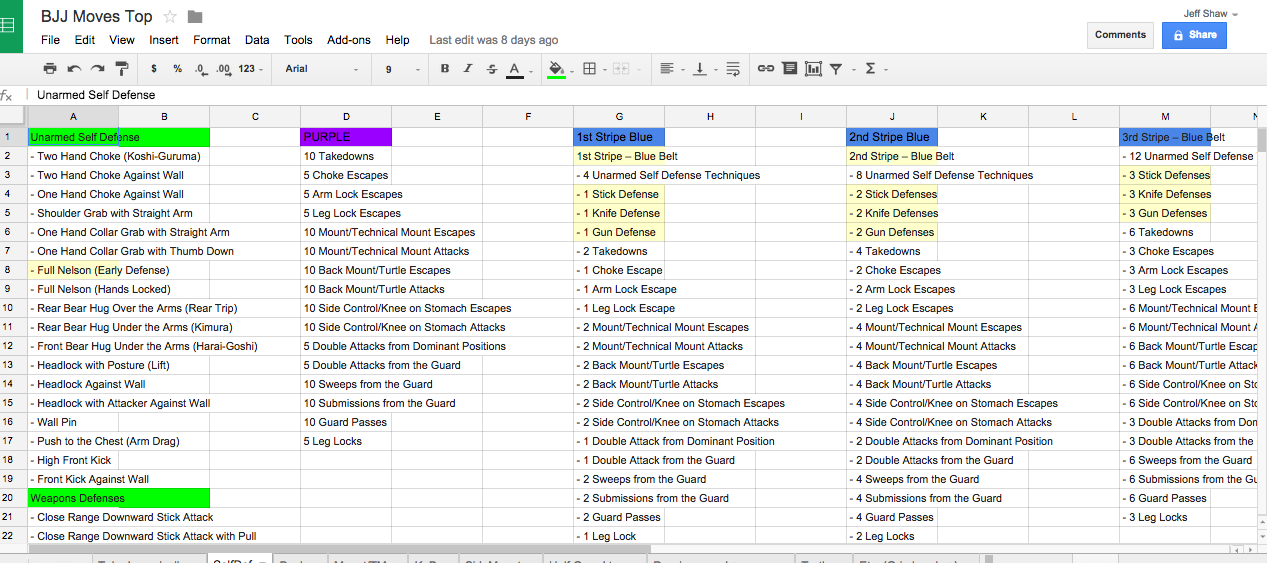
4. Perspective
You’re going to be training a long time, and whatever results you get are just a small blip on that larger radar screen. Saulo Ribeiro is a legend, and he never won a tournament until he got his black belt. Don’t plan your UFC career if you win, and relax if you lose. Either way, try to improve next time.
3. Down Time
You should know that many tournaments will have you waiting for a long time before your division. This is especially true of white belts, who usually go last. This isn’t something you really plan for, unless you want to bring an MP3 player or a book, but something to be aware of.
2. Learning
Whatever happens, it’s not a wasted experience if you learn something — and you will. Consider having a friend videotape your matches, or at least take photographs. I’ve had perhaps 100 tournament matches, and was able to reconstruct what happened in most of them based on video and pictures. This will be very helpful to you down the road, so don’t miss that opportunity.
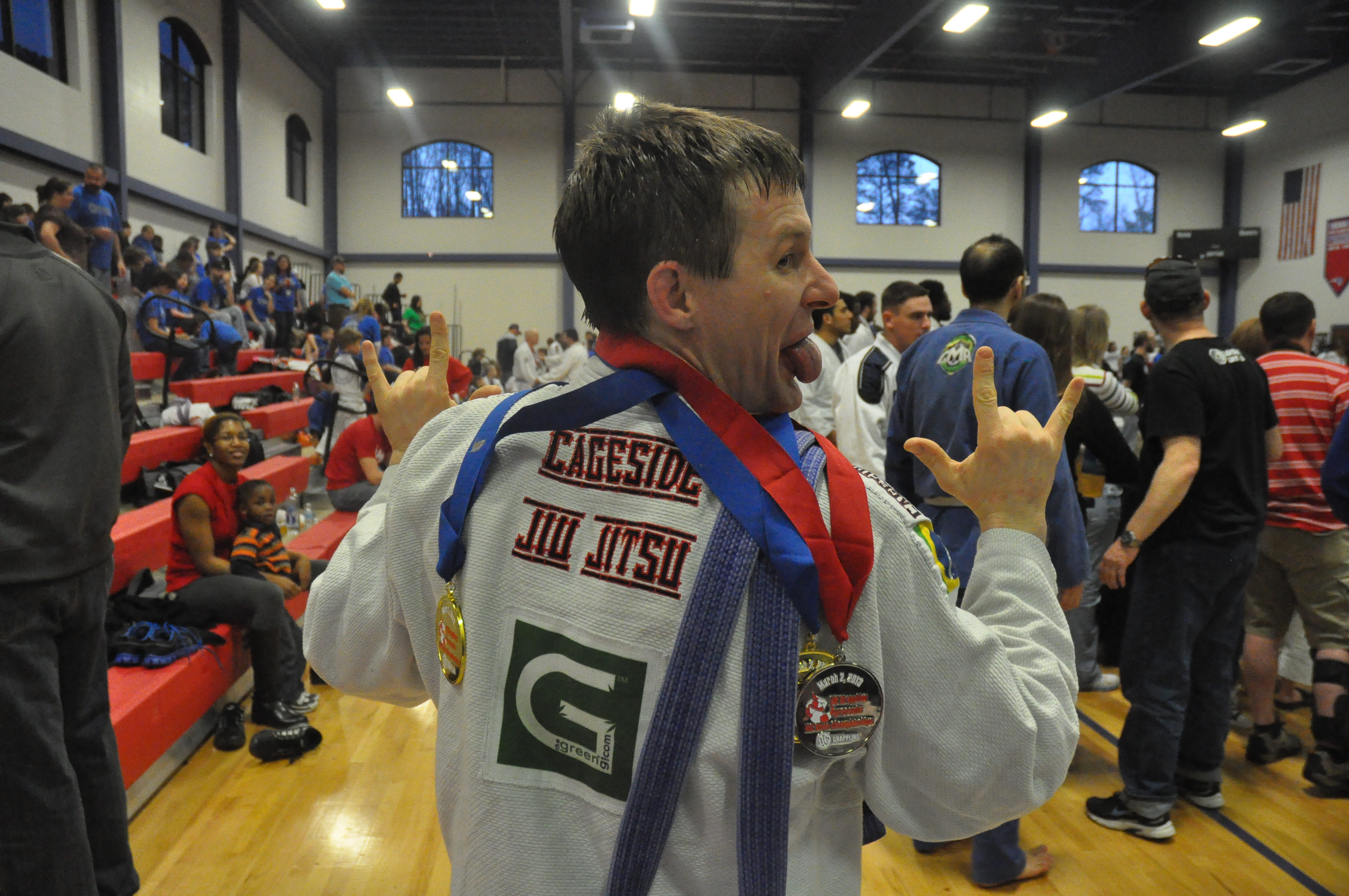
And the number one thing to think about before your first tournament is …
1. Nothing.
Just go out there and do it. Don’t stress yourself out too much: this is what you do for fun. As a wise man with ties to Durham once said: “Don’t think too much. It’ll only hurt the ball club.”
Good luck, have fun, stay safe, and go train.
